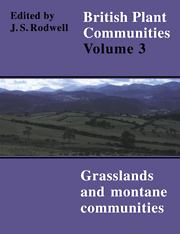Book contents
- Frontmatter
- Contents
- List of Figures
- Preface and Acknowledgements
- Preamble
- Mesotrophic Grasslands
- Community Descriptions
- Calcicolous Grasslands
- Community Descriptions
- Calcifugous Grasslands and Montane Communities
- Community Descriptions
- Index of Synonyms to Grasslands and Montane Communities
- Index of Species in Grasslands and Montane Communities
- Bibliography
Introduction to Calcifugous Grasslands and Montane Communities
Published online by Cambridge University Press: 04 July 2020
- Frontmatter
- Contents
- List of Figures
- Preface and Acknowledgements
- Preamble
- Mesotrophic Grasslands
- Community Descriptions
- Calcicolous Grasslands
- Community Descriptions
- Calcifugous Grasslands and Montane Communities
- Community Descriptions
- Index of Synonyms to Grasslands and Montane Communities
- Index of Species in Grasslands and Montane Communities
- Bibliography
Summary
The sampling of calcifugous grasslands and montane vegetation
Compared with their calcicolous counterparts, swards with a prevailingly calcifuge flora, long known in Britain as acid or acidic grasslands, have commanded somewhat sporadic interest. In the earliest descriptive accounts, for example, fine-leaved grasslands in the uplands received much less attention than communities dominated by Molinia caerulea and Nardus stricta (Tansley 1911) and, only with the agriculturalists’ concern to recognise different grades of hill pasture, was more precise classification of the better-quality swards undertaken. Then, though it quickly became apparent that such grasslands in the north and west were generally similar to grazed calcifugous swards and grass-heaths persisting locally in the south-east, no concerted effort was made to integrate these vegetation types into a single framework (Tansley 1939). Also, subsequent attempts to develop an overall perspective on these grasslands have usually relied on rather compendious definitions of a ‘Festuca-Agrostis complex’, within which somewhat disparate kinds of sward have been treated together. For the present survey, then, we were very concerned to begin afresh, benefiting from this wealth of experience, but sampling the full range of calcifugous grasslands from throughout Britain and, within the context of the broader survey, defining communities free of preconceived notions about how they ought to relate to one another, or to more calcicolous and mesotrophic swards and floristically similar heaths and mires.
We wished to do full justice to the distinctive elements among our montane vegetation. These were among the first plant communities in Britain to be described in a phytosociological fashion (Poore 1955c, Poore & McVean 1957, McVean & Ratcliffe 1962), and we were very conscious of our indebtedness to the insights of these early accounts. At the same time, we tried to avoid any over-representation of rare or more species-rich assemblages among the data, and many samples were collected from commonplace and run-down grasslands, from among derelict heaths and mires, and in the improved and afforested landscapes that are now so widespread through the upland fringes. As always, samples were located strictly according to the floristic and structural homogeneity of the vegetation and, though more intricately patterned swards and chaotically varied stands of tall-herb and fern vegetation sometimes posed problems, uniformity was usually not hard to detect.
- Type
- Chapter
- Information
- British Plant Communities , pp. 277 - 288Publisher: Cambridge University PressPrint publication year: 1992

